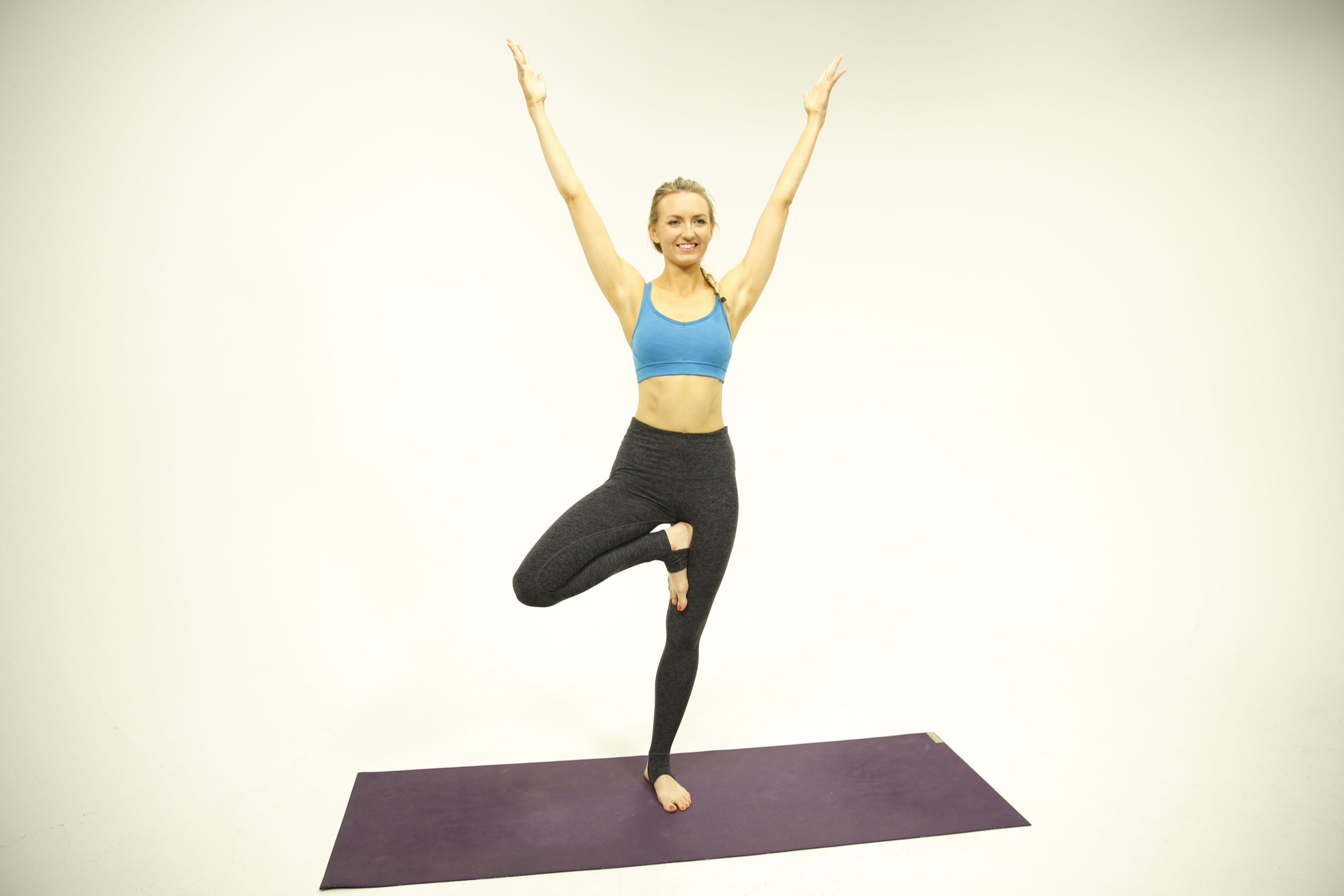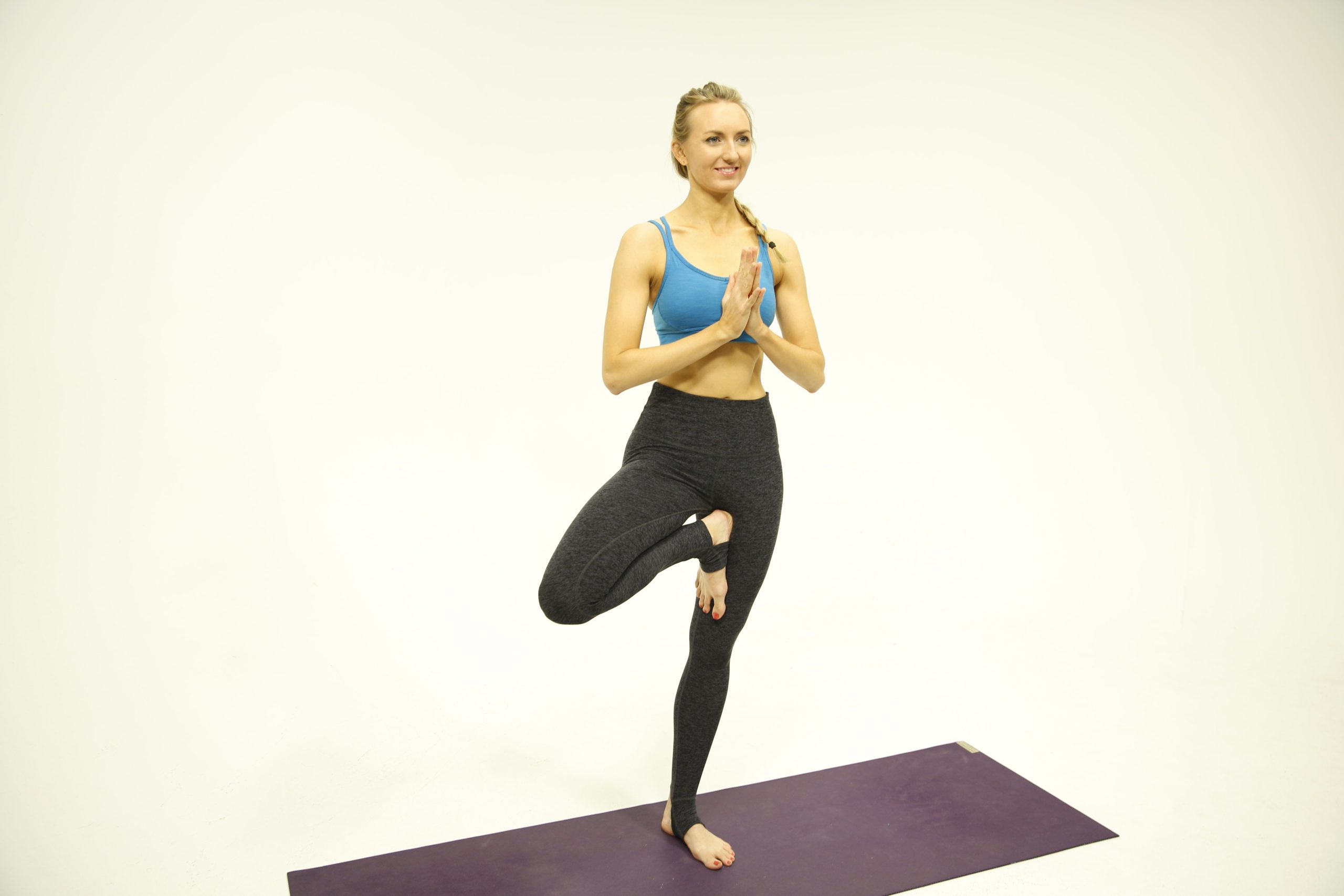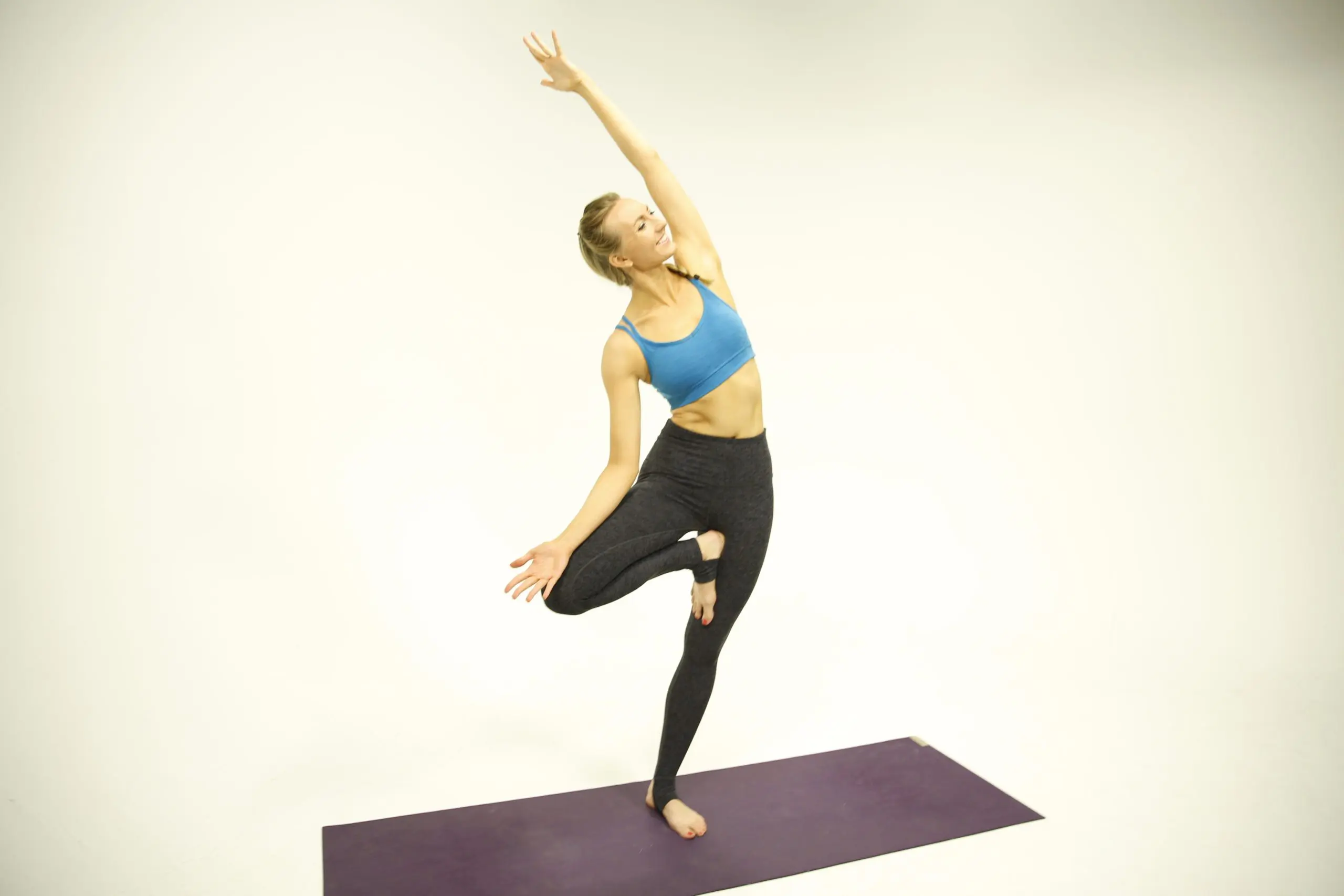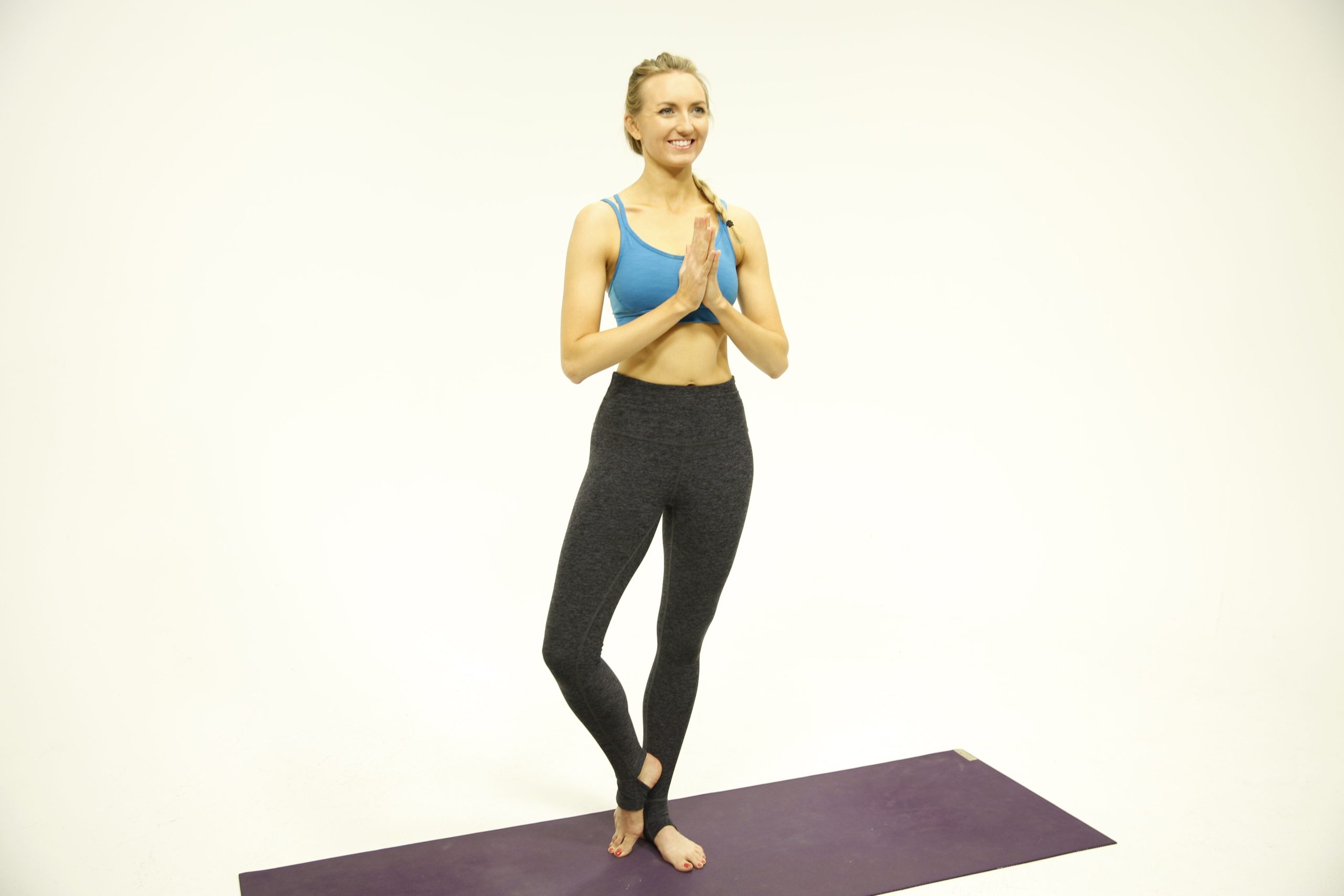(Vrikasana): Techniques, Benefits, Variations

Tree Pose Prep & Practice
1
Beginning in Mountain pose (Tadasana). Bring hands in prayer at heart center and begin to root into the right foot, bending the left knee and coming onto left toes. Focus your gaze slightly down and a few feet in front of you. Take a few breaths here, finding your focus as you prepare for the pose.
2
Bring your left foot to the inside of the right ankle, shin or thigh – taking care to avoid placing the foot on the knee. Left foot presses into the right leg, left thigh externally rotates from the hip.
3
Hips in neutral alignment, square forward, low abs firm in and up, muscles of right leg firm up as right foot grounds down.
4
Inhale arms up over head, biceps firm toward each other, fingers energized. Soften tops of shoulders away from the ears. Breath is steady, release any tension from the face as you maintain focused gaze.
5
To come out of the pose, on an exhalation lower leg and arms back down into Mountain (Tadasana), prepare for second side.



Variations/Modifications
- Practice with foot on ankle and toes on floor (hip or knee issues)
- Practice near wall or with back to a wall (balance issues)
- Hands remain at heart center or come to hips (shoulder injury)
Physical, Mental and Emotional Benefits
- Improves balance and focus
- Strengthens feet, ankles, calves and thighs
- Stretches inner thigh and tones outer hip muscles
- Cultivates grounding and self-reliance
Contraindications
- Hip or Knee injury (see modifications)
- Balance Issues (see modifications)
- Shoulder Injury (see modifications)
Thoughtful Sequencing
Mountain (Tadasana), Tree (Vrikasana), Inhale arms up, Exhale to heart 3X, Mountain (Tadasana), Inhale arms up, Exhale to Forward Fold (Uttanasana) 3-5 breaths, Inhale to Mountain (Tadasana) 3-5 breaths, option to close eyes. Repeat sequence practicing Tree (Vrikasana) on other side, end in Mountain (Tadasana).
Try Tree Pose On The Blog
- How to Easily Modify 6 Common Yoga Poses
- Chakra Yoga: The Best Yoga Poses To Balance Your 7 Chakras
- Earthing Yoga 101: 6 Poses To Connect With The Earth (Root Chakra)
- What is Drishti? How to Use Drishti in Your Yoga Practice (And Life)
- Yoga For Runners: 7 Poses That Will Help You In The Long Run
- The Basics of Hatha Yoga: 10 Classic Hatha Yoga Poses
A Few Notes
Tree pose, Vrksasana in Sanskrit, is a balancing posture to help open the hips and find stillness and balance in the body and the mind.
The posture requires you to keep your balance by standing on one leg and bringing your lifted foot to your inner thigh. If you aren’t able to bring your lifted foot to your inner thigh, then the foot can be placed below the knee on the calf muscle, or on the ankle or the floor. The latter is a good starting point, especially if you find balancing a challenge and with time you can build yourself up to bring the foot to your inner thigh.
Starting at the foundation of the balancing posture, with the foot position of the standing leg on the floor. You want to make sure you are distributing the weight evenly throughout the sole of the foot into the mat, and lift up through the inner arch of the foot. When practicing tree pose, try to shift your weight around and see how it can switch up your balance, the aim is to keep it neutral. Your standing leg needs to feel strong and grounded, without locking the knee joint out, while engaging the surrounding muscles and switching on your glutes.
There are two forces of energy in tree pose. As you ground down and press down through the standing foot, use this to lift up and lengthen throughout the body, up the spine, and out the crown of your head. When standing rooted and tall in your tree pose, become aware of these two energies.
In tree pose you want to try to keep your pelvis as neutral as possible with your hips level with one another. Keep your standing leg hip facing forwards, and when you bend your lifted leg out to the side to make a v shape, allow that hip to open out to the side. When we bend one knee out to the side our hips have a tendency to become wonky, so try to keep your awareness on the pelvis, keeping it neutral.
Next, bring your left hand and right hand together in prayer position, Anjali mudra, in front of your chest. Become aware of the pressure and sensations in the hands and try to meet the sole of the foot to the standing leg with the same pressure and level of awareness. When you feel balanced, reach your arms up toward the ceiling, allowing your shoulder blades to relax down the spine. Try to keep the length in the front and back sides of your torso, without arching the spine as you lift your arms. This can require a level of strength in the back, which will come with continued practice.
To help with concentration and balance, find a spot on the wall or object ahead of you to focus on, this is your Drishti, your gaze point, to aid you in finding balance and your full expression of tree pose. With time and practice, you can treat your balancing poses like meditation, finding peace and stillness amongst the chaos in the mind and the body. These pointers can be applied to all standing poses in your yoga practice.
Tree pose activates and strengthens your hip, back, tummy, and shoulder muscles. These muscle groups are often referred to as the core muscles and will help in your yoga practice and other exercises you may do off the mat. Having a strong core reduces back pain and the risk of injury.
There are a few modifications for Vrksasana, Tree pose, which are mainly to do with the legs. As previously mentioned you can place your foot in many ways. In a beginners yoga class, your yoga instructor will give you options, such as placing your foot on the floor or the ankle, the calf, or the inner thigh.
For more advanced yoga practitioners you may place your lifted foot into a half-lotus position. This requires a deeper opening at the hips and strength in both legs and is the starting position for Ardha Baddha Padmottanasana, (half bound lotus standing forward bend), a standing balancing pose that is usually found in Ashtanga yoga.
Tree pose, Vrksasana, comes from the Sanskrit words vṛkṣa meaning ‘tree’, and asana meaning ‘posture’. We can learn a lot from trees; to be grounded, rooted, still, and poised like a tree, giving yourself space to bend, but not break. And most of all continue to grow! However, we aren’t stuck to the ground like a tree, so allow yourself to move and flow with the currents of life, staying resilient and stable.
Want more yoga pose tutorials? See more in my Yoga Pose Directory.
Learn how to do 11 of the most popular yoga poses correctly. Free video + PDF download.









